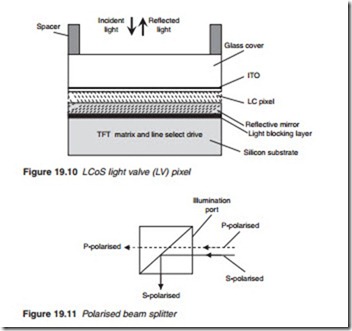Liquid crystal on silicon systems
The liquid crystal on silicon system, LCoS is a hybrid technology in that it is transmissive using LC light modulators and reflective by virtue of a back passive mirror (Figure 19.10). Incident light goes through the LC pixel which controls its brightness by its polarisation state. It is then reflected back by the mirror to pass through the same LC pixel again, a double pass. Being a reflective system, the transistor, shift register and driver circuitry can be constructed beneath the LV giving the LCoS LV a very high aperture ratio approaching 90%. The silicon substrate contains all necessary transistors, data and address drives. Although the traditional analogue addressing is common for LCoS panels, digital addressing has been developed and applied successfully providing stable and uniform grey levels, low fabrication costs and higher reliability.
The fact that the reflected light shares the same path as the inci- dent light necessitates the use of an optical device to separate them.
This is carried out by a polarising beam splitter (PBS). The PBS has four sides or ports with the input side known as the illumination port. Polarised light entering the illumination port will be reflected or deflected into one of the other three ports depending on its polarisation state. For instance, a P-polarised light entering the illumination port would pass right through to the opposite port, while an S-polarised light would be deflected by 90º as shown in Figure 19.11. Since the inci- dent and reflected light in an LCoS LV are differently polarised, the use of a PBS may be used to separate them.
There are two types of LCoS-based projector architecture. The first uses three PBSs with a combining x-cube (known as 3 X PBS/x) in a similar configuration to the 3-panel HTPS-based system. The second uses a single unit composed of PBSs and retarders (known by their trade name of ColorSelectTM) that carries out both the polarising/splitting functions of the PBS and the splitting/combining functions of the dichroic mirrors and x-cube. The PBS/retarder combination is capable of very compact colour management systems.
